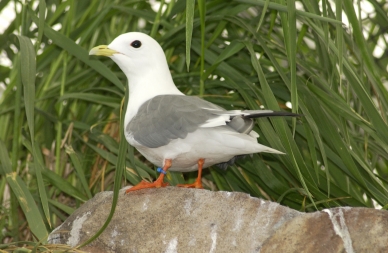Alaska Species Explorer
All
x
- – No known individuals remaining.
- – Known only to survive in captivity, or as a naturalized population outside its historic range.
- – Extremely high risk of extinction in the wild.
- – High risk of extinction in the wild.
- – High risk of endangerment in the wild.
- – Likely to become endangered in the near future.
- – Lowest risk. Does not qualify for a higher risk category. Widespread and abundant taxa are included in this category.
- – Not enough data to make an assessment of its risk of extinction.
- – Has not yet been evaluated against the criteria.
Red-legged Kittiwake
- – No known individuals remaining.
- – Known only to survive in captivity, or as a naturalized population outside its historic range.
- – Extremely high risk of extinction in the wild.
- – High risk of extinction in the wild.
- – High risk of endangerment in the wild.
- – Likely to become endangered in the near future.
- – Lowest risk. Does not qualify for a higher risk category. Widespread and abundant taxa are included in this category.
- – Not enough data to make an assessment of its risk of extinction.
- – Has not yet been evaluated against the criteria.
In Alaska, they nest on St. George, St. Paul, and the Otter islands in the Pribilof Islands, and on Bogoslof and Buldir islands in the Aleutian Island chain. The St. George colony in Alaska contains over 80% of the world’s population. The second largest breeding colony is in Russia on the Commander Islands. They breed at only five to six locations in the world, all in the Bering Sea.
The Alaskan breeding population is estimated at 209,000 birds and is classified as highly imperiled and a species of concern. Globally they are classified as a vulnerable species. Very little information is known about the species other than from breeding sites. The following actions are recommended to maintain the population: monitor food supply, determine wintering locations, reduce negative fishery interactions, implement buffer zones around colonies, and continue with rat prevention programs.
Mostly white, but the upper surface of the wings and back are dark gray. Wings are tipped with black, the legs and feet are fire engine-red, and the bill is yellow.
They nest on ledges of vertical sea cliffs up to 900 feet high with other species of seabirds, including their more common relative, the Blacklegged Kittiwake (Rissa tridactyla).
- They have large eyes for hunting at night especially during the squid migration
- The Russian translation of their name means “The bird that talks a lot”
- Form large hunting groups called ‘melees’ with black-legged kittiwakes
- They are plunge divers and cannot fly under water like other pelagic birds














